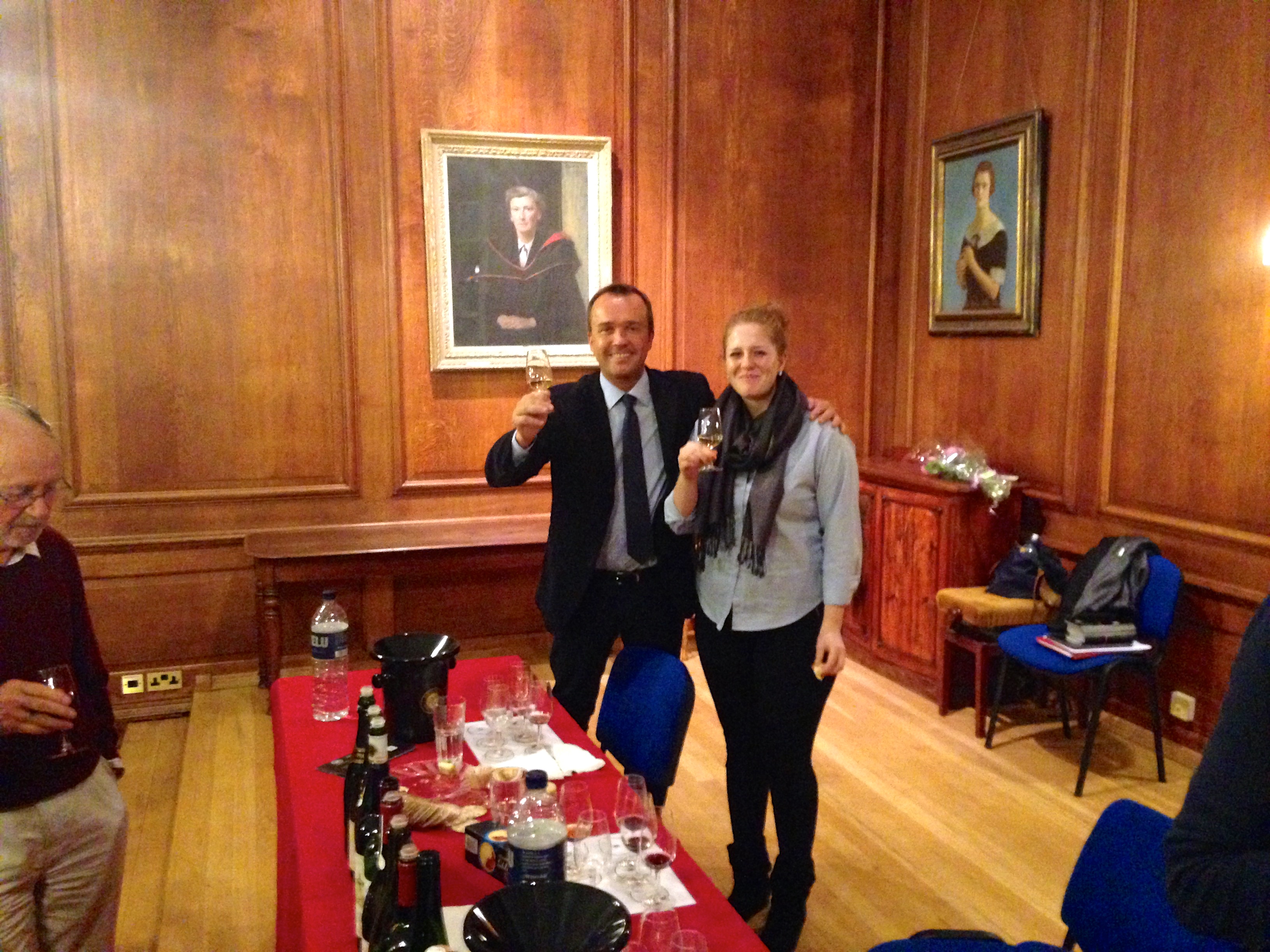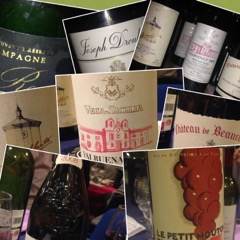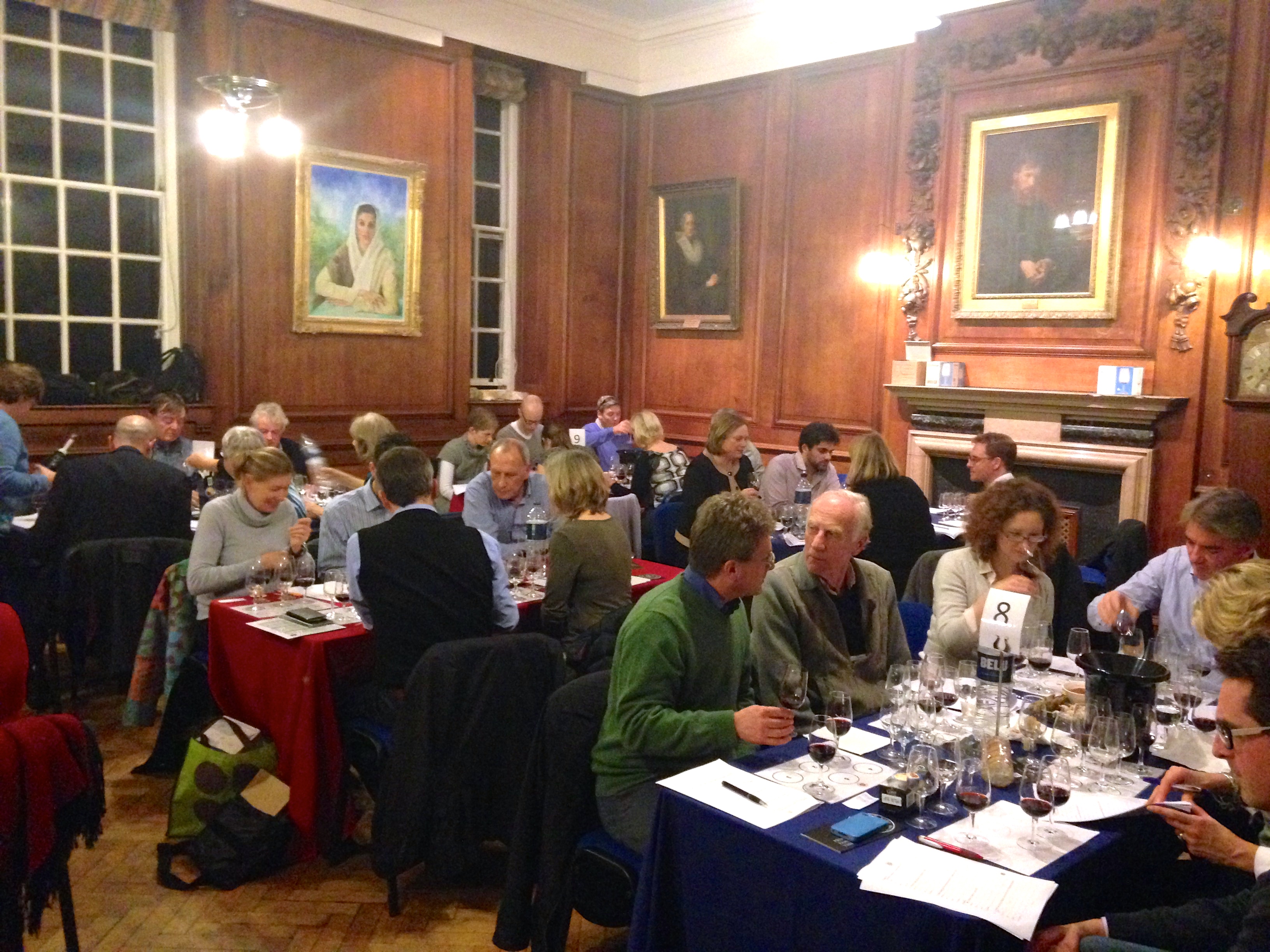This, said Hans Sundin, introducing the Oxford Wine Club’s PFV tasting was going to be ‘amazing’.
He was absolutely right. There have been very very few such tastings in England. Ably and engagingly presented by Christophe Brunet (the PFV’s Ambassador) and Christina Torres we had an extraordinary evening. Twelve wines in total – one from each of the eleven families plus a bonus Pol Roger champagne of the 2000 vintage – and some excellent canapés produced to Christophe’s specifications.
 Christina –already a Club ‘star’ after the Torres Family tasting earlier this year – was joined at the top table by Christophe and our President Michael Palij MW (though he had to leave early to take care of his new born daughter). Christophe, a sommelier by training, had first worked for the Torres family coordinating wine and food events worldwide where he got to know Miguel Torres (Christina’s uncle). The PFV owes its origins to a meeting between Miguel and Robert Drouhin of Maison Joseph Drouhin in Burgundy who recognised that multi-generational family businesses such as theirs enjoyed extraordinary advantages but faced special issues. Membership is limited to twelve companies (there are currently eleven) and only those with 100% family ownership can qualify. Hence, as Christophe explained, early members such as Mondavi and Jaboulet are now out of the PFV.
Christina –already a Club ‘star’ after the Torres Family tasting earlier this year – was joined at the top table by Christophe and our President Michael Palij MW (though he had to leave early to take care of his new born daughter). Christophe, a sommelier by training, had first worked for the Torres family coordinating wine and food events worldwide where he got to know Miguel Torres (Christina’s uncle). The PFV owes its origins to a meeting between Miguel and Robert Drouhin of Maison Joseph Drouhin in Burgundy who recognised that multi-generational family businesses such as theirs enjoyed extraordinary advantages but faced special issues. Membership is limited to twelve companies (there are currently eleven) and only those with 100% family ownership can qualify. Hence, as Christophe explained, early members such as Mondavi and Jaboulet are now out of the PFV.
As Christina said later, when your ‘family’s name is on the label’ you have an obsession with quality, you take any problems very seriously and, above all, you think long-term. Hence, Miguel Torres has bought land in Catalonia at 1200 metres altitude, which is currently good for frost and not much else, since if global warming continues existing vineyards will face serious problems. The Torres Family might even consider moving the business to Chile to ensure its very long-term future.
 Each family contributed one wine to the tasting – and we are very grateful to them for some spectacular wines. We started with Pol Roger 2004 Champagne Brut. Christophe outlined the history of the firm which dates back to 1840, though ‘Pol’ was not added to the family name until 1900 by Pol Roger’s sons. 2004 is an often under-rated vintage of ‘classic elegance’, a blend of 60/40 Pinot Noir and Chardonnay which is vinified in stainless steel to give it freshness and coiled power. Michael recollected his first visit to Pol Roger in 1992, turning up on a motorbike and with a ‘blue Mohican’ haircut to be received with characteristic courtesy and generosity by Hubert de Billy. In Michael’s view the steady increase in the price of NV champagne now makes vintage champagne a good buy relatively speaking.
Each family contributed one wine to the tasting – and we are very grateful to them for some spectacular wines. We started with Pol Roger 2004 Champagne Brut. Christophe outlined the history of the firm which dates back to 1840, though ‘Pol’ was not added to the family name until 1900 by Pol Roger’s sons. 2004 is an often under-rated vintage of ‘classic elegance’, a blend of 60/40 Pinot Noir and Chardonnay which is vinified in stainless steel to give it freshness and coiled power. Michael recollected his first visit to Pol Roger in 1992, turning up on a motorbike and with a ‘blue Mohican’ haircut to be received with characteristic courtesy and generosity by Hubert de Billy. In Michael’s view the steady increase in the price of NV champagne now makes vintage champagne a good buy relatively speaking.
The second wine was the 2012 vintage of Cervaro della Sala from Marchese Antinori. As Michael said, this family were making wine 100 years before Columbus set sail – 27 generations since 1385. Piero Antinori (father to the current generation of Antinoris) was both a reformer of Tuscan wine and the first real promoter of the ‘Super Tuscan’ concept. The Cervaro della Sala wine could be classed as the first real white Super Tuscan or perhaps Super-Umbrian). Deep gold in colour this wine had a rich bouquet of tropical fruit overlain with new oak. Right now the impact of 12 months in American oak was a bit overwhelming but, fascinatingly, the smoked salmon canapé ‘ate’ the oak, showing the wine as it will be with a few years more maturation. It’s a 90% Chardonnay, 10% Grechetto blend – the latter grape giving a remarkable freshness to the wine.
Wine no 3 was Joseph Drouhin’s Chassagne-Montrachet 2011 Morgeot Premier Cru Marquis de Laguiche. This estate, owned by the family of the Marquis de Laguiche, has been leased (‘on a handshake’) by the Drouhin family since 1946. The vineyard is densely planted (10k vines per ha) and has been run for many years on bio-dynamic lines – part of the ‘revolution’ inspired by Philippe Drouhin. This is classic Chassagne, lean, elegant and age-worthy. The wine was pale gold with a complex, rich nose - citrus, a note of almonds and subtle oak (only 20% new) that neatly complemented the smoked salmon and dill scones. The finish is already intense but this is a wine that will age for 15-20 years, justifying its £50 price tag. Christophe noted the Drouhin’s concern over their inability to control prices in the after-market and their worry that this wine, like others in the PFV portfolio is becoming subject to speculation and profit-taking.
Wine no. 4 was Egon Müller’s Scharzhofberger Kabinett 2011. Perfectly balanced and deliciously refreshing this wine from one of the greatest German terrains was pale gold, still with the bubbles of youth and an aroma of lime, white flowers and the unmistakeable note of kerosene. It’s just off-dry (perhaps 40-50 g/l of sugar) with a long finish and the evident capacity to age for many years. The Müller family who have been growing grapes and making wine here for over 200 years on these steep and demanding slate slopes, are botrytis experts and Christophe commended the TBA wines (even if their price has now reached stratospheric heights). The Kabinett is the second level of the Müller wines , decent value at £30-35 and a perfect match for fish and for dishes with a hint of chilli. Global warming will be beneficial – at least in the short term – for German wines and as a class they now represent not only good value but remarkable quality. Christophe went on to speak more generally about climate change, pointing out that whereas once two or three good vintages in ten was the Bordeaux norm, it’s now closer to eight in ten – an issue of concern to the PFV generally. Where do they need to be; what land do they need to control to ensure they can continue making wines to the same style and quality.
After these first four whites we moved on to red wine. The first flight of three wines took us to Italy, Spain and the Rhône, then back to Spain before finishing with Spain (again) and France.
Wine no. 5 was the Tenuta San Guido Guidalberto 2004. This wine comes from the Bolgheri property on the Adriatic (also home to Sassicaia). It’s a 60/40 Cabernet Merlot blend, grown on land that’s not dissimilar in structure to Bordeaux and this bright and soft blend from a great year is the second wine - ranking behind Sassicaia (the ‘family wine’ for over 30 years before it was commercialised in the late1960s). Still dark in colour with a bright nose of plum, cassis and a touch of the cigar box, the Guidalberto has soft tannins and good length. Some members thought it had lost its fruit on the palate; others praised the cassis and mushroom flavours and long finish. This, said Christophe, was a wine for red meat (the beef and horseradish canapé worked particularly well) but also for any dishes based on the classic sofrito mix of tomato and onion (such as our chicken skewer with a salsa dip).
Next up was wine no. 6, the Vega Sicilia 2009 Valbuena 5◦ Ano. The name comes from the five years this wine spends in oak and the oaking regime created by Xavier Ausuas for this more modern style of Ribera del Duero is very precise: 37months in large old oak casks to start, then 15 months in new American and French oak before three more months in small oak casks and a final period of two in large old oak casks to allow the wine to integrate. This wine comes from a 100 ha vineyard (planted in a property of 1000 ha) and the family have set a target of planting 1 million trees there to restore the ancient landscape (another example of working for the long-term). The blend here is 93% Tinto Fino and 7% Malbec / Merlot. Slightly darker than the Guidalberto this has a subtle yet concentrated nose with dark cherry and plum notes, plenty of cassis fruit in the mouth with a hint of liquorice to cut the sweetness. Soft but powerful tannins, a full mouthfeel and a long finish. This is a wine for food and both the beef and duck canapés were a good complement.
Wine no. 7 was the Famille Perrin Chateau de Beaucastel Chateauneuf-du-Pape 2008. Once again we were spoilt. The 2008 is perhaps the greatest of recent vintages from this extraordinary family (recognised this year by the choice of the brothers François and Jean-Pierre as Decanter’s 2014 Men of the Year in 2014). The 7th generation of the Perrin family (all seven of them) are now engaged in the business – a ‘great advantage’ observed Christina wryly. As she said, the strength and continuity of family businesses depends not just on one or two founding individuals but a long-term involvement by successive generations. The PFV are actively fostering this familial involvement with ‘exchange visits’ between the vineyards and wineries to help transfer skills amongst each new generation. It’s not all cellar work though. As Christina said the families are a pretty social bunch and annual family meetings (organised by Christophe) are there to foster friendship as well as long-term planning. The Perrin Beaucastel is one of the few to use all the 13 ‘official’ grape varieties (not to mention a couple of extra variants such as different forms of Counoise) but the blend is dominated by Mourvèdre and Grenache at 30% each with another 20% split between Syrah and Counoise. The Beaucastel vineyards were pioneers first in organic farming in the 1950s and then, from 1974, bio-dynamic farming. Slightly lighter in colour than the other two wines in the flight, the Beaucastel had a smoky, herbal nose with hints of licorice, soft tannins in the mouth and beautifully fresh acidity.
For wine no. 8 we moved back to Spain and a Torres family wine. This was the Mas La Plana 2010. Here we were in 100% Cabernet Sauvignon territory, and this is a wine born of Miguel Torres’ studies in France and his determination to introduce French varietals to Penedès, ‘Loco’ was his grandfather’s reaction but Miguel had his way by the mid-60s and Mas La Plana was born in 1970. Its victory in the 1979 Gault-Millau Wine Olympiad shocked the French wine establishment and put Torres on the world’s wine map. The original ‘black label’ of the first ‘Gran Corona Reserve’ survives as does the Burgundy bottle. 2010 was a cold, somewhat rainy year but the wine is layered with flavour, depth and concentration. On the nose there’s blackcurrant and liquorice fruit with a note of cacao and hints of torrefaction. In the mouth is fresh and clean with well integrated oak and a long, slightly peppery finish. It’s perhaps not yet fully integrated but has many years of improvement ahead of it. The price is steadily climbing and today’s £60 may well be seen as a bargain in years to come. Tasted with our canapés it was a perfect match for the beef and duck.
The last red wine, no. 9, was Le Petit Mouton de Mouton Rothschild 2004.Philippine de Rothschild, slightly to the surprise of the more antediluvian Bordelais, proved a worthy successor to her formidably innovative and driven forbears. Bought by Nathaniel de Rothschild in 1853, this estate got on the wrong side of the Premier Cru divide in the 1855 classification and it took until 1973 for Baron Philippe to convince Jacques Chirac’s government to promote it to the top rank of the classification. He also created the tradition of artists’ labels. These originally commemorated the events of that year but with the death of Gandhi in 1948, Baron Philippe decided to give the artists their head, recruiting such as Picasso, Chagall, Francis Bacon (and even the Prince of Wales). For Le Petit Mouton, the second wine of the estate, the key concept is buvabilité. It is, said Christophe, a ‘very British style’ focusing on elegance rather than power. The blend of 87% Cab Sauv, 4% Merlot and 13% Cab Franc gives it freshness and a very pleasant nose of dark cherry, spice and hints of vanilla. There’s more red fruit in the mouth with a touch of pepper. Drinkable it certainly is, though some members wondered if there was enough fruit in the middle palate and enough complexity to sustain the wine for the future and justify the £100 plus price tag.
Christina took over to talk us through wine no 10, the Gewurztraminer Vendange Tardive 2007 from the Famille Hugel. As well as her family responsibilities she is also Brand Manager for this wine with J Fells. This is another long-established family, going back 13 generations to 1639. It’s currently run by Jean-Frederic but Christine underlined the importance of Jean Hugel who re-established late harvest wines in Alsace. He pushed through ‘Hugel’s Law’ in 1984 to set the regulations for Vendange Tardive (VT) and Sélection de Grains Nobles (SGN) and the family produce some of the world’s finest examples of these wines. These wines have a slow fermentation and huge ageing potential – particularly vintages such as 2007 (which we were privileged to taste) and 2009. The wine-making style is minimalist with only one racking, natural clarification and light filtration. Like a number of other PFV wines tasted on this occasion, Hugel use the Diam cork to ensure consistency and quality. This wine was rich gold colour in the glass, with aromas of lime marmalade, honey and flowers and notes of tropical fruit. Lots of sweetness but well balanced by vibrant acidity. At around £20 and perhaps decades of life to come, this is a wine to consider for any cellar. One of my personal favourites from the tasting, the Gewurztraminer went wonderfully well with the Colston Basset Stilton sourced from Well’s Stores in Abingdon.
Wine no. 11 was a radical switch. We moved from France to Portugal and Graham’s 20 year old Tawny Port from the Symington Family estates. Christophe enthused over Porto, still, he said, one of the most interesting cities in Europe and still one of the cheapest. Well worth a visit, he reckoned. The Symington Family, which traces its wine roots back to the 1880s, has been described as a ‘Port Empire’ and they control a number of brands and many of the top quintas in the Alto Douro. The fifth generation is now in control of around 30% of the world’s premium ports and this wine is one of their flagship products. Tawny ports are of course aged in cask rather than in tank and this allows for a slow oxidation and evaporation (the ‘angel’s share’). The colour lightens to golden brown and the exposure to oxygen gives flavours of nuts, sticky toffee pudding and dried fruit – all of which were evident in this wine. 2011 was a great vintage (the equal of 1945 and 1963) and this wine was sweet and fresh. It goes well with chocolate; it’s best served slightly chilled and, if you’re really feeling extravagant, you can get a 2.1 litre ‘Tappit Hen’ bottle. It’s the same height as a normal bottle but much greater circumference (and weight). You might need Christophe’s influence however…

That was the formal end to the tasting but we were treated to a final glass of Pol Roger 2000 Champagne Brut (spicier than the 2000, with notes of toasted brioche and almonds) as we chatted, got stuck into the Stilton and the Lincolnshire Poacher and fired more questions at Christophe and Christina, to whom we owe a great vote of thanks. Thanks are also due to Hans Sundin and Sarah Eccles for their organisation of this tasting and for sourcing some excellent food.
GH November 2014